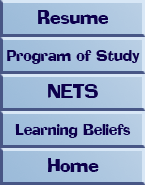NETS I. | NETS II. | NETS III. | NETS IV. | NETS V. | NETS VI.
I. Technology Operations and Concepts.
|
Teachers:
| A. demonstrate introductory knowledge, skills, and understanding of concepts related to technology (as described in the ISTE National Education Technology Standards for Students) |
When designing any learning situation it is important to ensure that students are engaged in meaningful learning activities. I have begun looking at my own teaching methods as well as those of others to help assess if the technology being used is used in an effective manner.
In my technology usage assessment case study, I had the chance to evaluate how another teacher was using Kid Pix to illustrate Nursery Rhymes. In addition to evaluating whether the activity was supporting meaningful learning traits (active learning, constructive learning, intentional learning, authentic learning, and cooperative learning) I was also able to reflect upon how the lesson could be improved so that it better supported a meaningful learning experience.
During my course of study I have also been able to reflect on how teaching, learning and technology are related and connected. In the beginning of my studies I explored this relationship in a concept map. This concept map primarily focused on how technology facilitates teaching and learning activities.
Later, I made a second concept map which showed teaching learning and technology organized in a circular pattern like a color wheel. The rainbow organization was my way of showing how the concepts blend together and support one another to make a whole picture. Where two primary concepts overlap I used a secondary color. This showed visually where teaching, learning and technology overlap and support one another. Finally, I faded the colors from bright near the center to a lighter color as they become more specific with the examples.
| B. demonstrate continual growth in technology knowledge and skills to stay abreast of current and emerging technologies. |
Technology is constantly being improved and new advances in technology will help shape the future as well as change the way we teach, learn, work, and play. Because technology has changed so much in the last 50 years, it has become more important than ever for all professionals to continue their education to keep in step with new trends.
This year I began working closely with the School Technology Committee to become involved in technology changes at the school. The committee helps decide how to distribute new equipment as well as plan staff development workshops. I helped plan a mini-technology conference workshop for my school on web design in the classroom. The needs addressed in this workshop were based on interviews with teachers about the needs of the faculty as well as concerns discussed at Technology Committee Meetings. This workshop took advantage of some new creative software programs that the district has recently purchased for our school.
While experimenting with new forms of communication I began thinking of some ideas to supplement and enhance classroom studies and curriculum planning through the use of interactive websites and blogs. The blog I created, "Sarah-Sensei’s Blog," using WordPress was designed to be a resource for both teachers and students. Blogs can be used to direct students to interactive content on the internet and to provide students with more multimedia experiences to make studying art or other subjects more engaging. Students can use blogs to discuss or reflect on topics that are being studied in their classes and to post questions after school hours. Professionals may be invited to prepare a guest post so that students can interact with people working in different fields. Teachers may also use blogs to post lesson ideas, discuss new techniques and review resources on the web to help other teachers plan their curriculum. Although maintaining the blog daily was time consuming, I feel that it is an idea that is worth exploring and could easily be integrated into a class on a weekly basis.
NETS I. | NETS II. | NETS III. | NETS IV. | NETS V. | NETS VI.
Standards quoted from ISTE NETS - NETS for Teachers.

